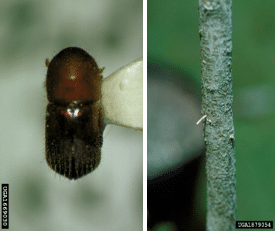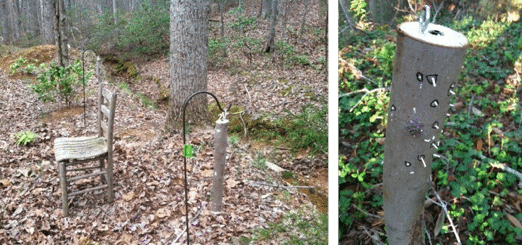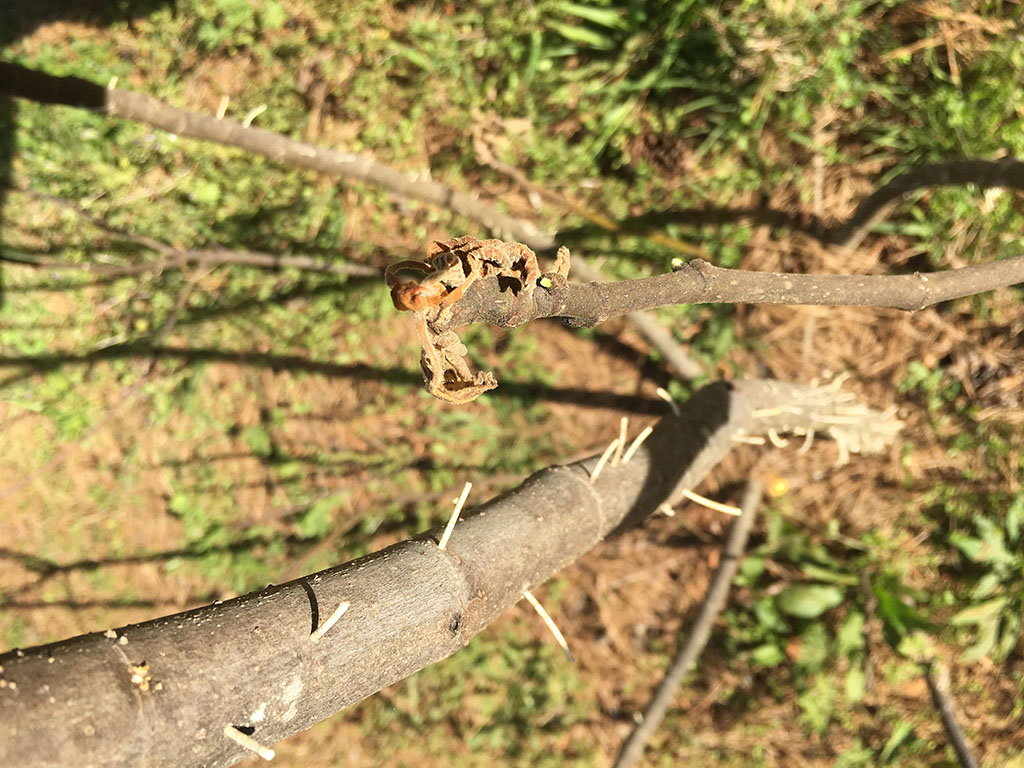Post authored by Paul J. Pugliesea and Shimat V. Josephb
aUGA County Extension Agent/Coordinator (Bartow County), Cartersville, GA
bAssistant professor, Department of Entomology, University of Georgia – Griffin Campus.

Granulate ambrosia beetle, Xylosandrus crassiusculus (Mot.) [Previously known as the Asian ambrosia beetle]
Introduction: Granulate ambrosia beetle (Fig. 1) is a serious pest of woody trees and shrubs in Georgia. These tiny beetles were first detected in South Carolina in the 1970’s and have spread across the southeastern US.
Host plants: Woody ornamental nursery plants and fruit trees are commonly affected. In spring or even in late winter (around mid-February), a large number of beetles can emerge and attack tree species, especially when they are young. Some highly susceptible tree species include Styrax, dogwood, redbud, maple, ornamental cherry, Japanese maple, crepe myrtle, pecan, peach, plum, persimmon, golden rain tree, sweet gum, Shumard oak, Chinese elm, magnolia, fig, and azalea.
Biology: The female beetles land on the bark of woody trees. Then, they bore through the soft wood and vascular tissues (xylem vessels and phloem) of the tree. They settle in the heartwood and begin making galleries. Eggs are laid in these galleries. Adults introduce a symbiotic fungi into the galleries as a food source for the developing larvae.
Symptoms: The initial sign of infestation is presence of boring dust pushing out of the bark as “tooth picks” (Fig. 1). Severely infested trees with granulate ambrosia beetle may show symptoms of stunting, delayed leaf emergence in spring, and extensive defoliation.

Monitoring and management: Once adults of granulate ambrosia beetle bore through the bark, there are limited control options to mitigate the problem. Those settled beetles in the heartwood of the tree are less likely to be exposed to insecticides. Also, the beetles do not consume the wood, which further minimizes their pesticide exposure. Pyrethroid insecticides such as bifenthrin or permethrin can be used as preventative sprays to repel invading females. Thus, the insecticide-application timing becomes critically important for management. The insecticide applications can be timed with trap captures or adult activity. The simplest method to determine adult activity in the area is using alcohol and a bolt of wood (Fig. 2). A wood bolt (about 2 to 4-inches in diameter and 2-feet long) can be utilized. Any hardwood species such as maple will work for building traps. A half-inch diameter hole drilled at the center of the bolt, about a foot deep, is filled with alcohol and the opening can be closed using a stopper cork. Ethyl alcohol or grain alcohol with 95-percent alcohol content (190-proof) can be found at most liquor stores. Hang several bolt traps along the woodland border of a nursery at waist height to determine beetle emergence and activity. Sawdust tooth picks (Fig. 2) begin to appear on the bolt when they are infested with adult beetles. Once tooth picks are detected on a bolt trap, daily scouting should occur on nearby trees.
An immediate spray using a pyrethroid insecticide on nursery trees is warranted upon detection of tooth picks on the bolt trap. Be prepared and ready to act quickly as soon as beetle activity is confirmed. If practical, the entire nursery should initially be treated with an area-wide application to repel beetle activity. If individual trees are found to be infested, immediately destroy infested trees and follow up with targeted spray applications in blocks with beetle activity. Generally, pyrethroids are not effective for more than a week as their residues quickly breakdown. Re-application of the insecticide is generally required at weekly intervals until spring green-up is complete in areas where the beetle pressure is moderate to severe.
Healthy trees can withstand a low level of beetle infestation. Timely irrigation and adequate fertilization of trees throughout the growing season will increase a tree’s tolerance to beetle infestation. Closely monitor traps throughout the spring for a second emergence of ambrosia beetles. Ambrosia beetles can have multiple generations throughout the year and are strongly attracted to trees that are drought stressed, injured, or excessively pruned. Pay close attention to irrigation needs during extended summer and fall drought periods to minimize tree stresses. Avoid mechanical wounding of trees with maintenance equipment that could invite ambrosia beetles to attack.
When to deploy monitoring traps: The monitoring traps should be deployed starting the first week of February in Georgia because warmer periods during a mild winter may trigger early beetle emergence and infestation.
References:
- Frank, and S. Bambara. 2009. The granulate (Asian) ambrosia beetle. Ornamental and turf. Insect note. North Carolina State University.
- Wells. 2015. Managing ambrosia beetles. UGA pecan extension
- Pest Alert: February Monitoring for Granulate Ambrosia Beetle - February 5, 2018
